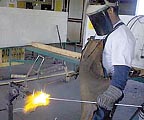Last month, in part one of this series, we covered auger flight wear and the application of the surfacing electrode. In this issue, we'll look at maintenance, checking and cutterheads.

Planned Periodic Maintenance
There are a number of different situations that will be encountered - the drilling contractor who has one set of augers, used very occasionally, to the contractor who has multiple auger rigs constantly in use. Remember that the cutterhead must be sharp and have the correct diameter in relation to the flights. If it is under-gauge, abused, damaged or has dull inserts, then it will not do much good to worry about the augers.Set up an auger maintenance and rotation schedule. The first down day of each month is a workable schedule for most; it is the easy to remember and easy to implement. On the scheduled day, check the diameter, condition and wear on the cutterhead and the lead auger. Assuming the lead auger is not damaged or in really bad shape, hardface it, and it is ready to go. The second month, hardface another auger, put the cutterhead on it and use it as the lead auger. Move the one you just took the cutterhead off of to the second position in the auger string and so on for a year. Try to do an extra one every time you have a slow period or an extra welder. Spend a little extra time to qualify another welder or two on the hardfacing process.
If you have more than an average number of augers, do one a week instead. Or, if you have many augers and the personnel to do the hardfacing, do one a day until you know where you are at. One big factor in a hardfacing program is that, if possible, it should be done at a time when the weather is inclement or the rig is down for some reason, etc. If it can be done under those conditions, it is money in the bank.
After one year, you will have at least a dozen augers hardfaced and by then, spending a couple of hours inspecting the augers and using your gauge(s), you easily will be able to figure if you should do one auger a month or one a year in the future. Depending on how often, and in what formations the augers are used, after you have all
the augers hardfaced, you may find out that checking and maintaining the cutterhead once a year and hardfacing the lead auger may be enough.
Checking
Checking is not uncommon with some electrodes and often it is desirable.
Checking helps reduce residual stress. Sometimes, if the deposit does not check, the residual (locked in) stresses can become so high that deep cracks or spalling result. If this occurs, there is a problem, and it may be desirable to force checking by spraying the hot deposit with a fine water mist or sponging the deposit with a wet cloth. Checking also may be promoted during the cooling period by lightly striking the deposit with a chipping hammer. In every case, consult the product information about the specific electrode being used - before you start hardfacing - so you will know the proper procedures and what to expect.
Cutterheads
The cutterhead, not included within the scope of this article, is nevertheless so important to the overall performance of an auger rig that it must be mentioned. The correct size of the major O.D. of a cutter head should be 5 percent to 15 percent larger than the major O.D. of the flights. Acker Drill, a leading manufacturer of augers, recommends 10 percent. It goes without saying that cutterheads must be sharp to secure maximum efficiency.If the cutterhead is smaller than the auger flights, accelerated flight wear, particularly on the leading edge of the leading auger, will result and the bore cannot be advanced more than 10 or 20 feet. The reason is that the oversize flights shear the excess wall material off into the undersize hole made by the cutterhead. Once the excess material is at the bottom of the hole, it continues to be compacted by the downward pressure of the oversize flights until early refusal is reached.
If the cutterhead is too large, material will fall off of the flights and have to be lifted again. The larger the cutterhead in relation to the flight size, the higher the percentage of material that will fall off the flights. The bottom of the hole never can be cleaned completely in this situation. However, these factors will vary considerably depending on the composition and the degree of consolidation of the formation.
The best tradeoff will be realized if the cutterhead is 5 percent to 10 percent larger than the flights. This initial relationship probably won't remain constant because the major O.D. of the cutterhead can wear faster than the flights. Therefore, both must be measured occasionally to make sure that relationship between the two always is within tolerance.
ND
Report Abusive Comment